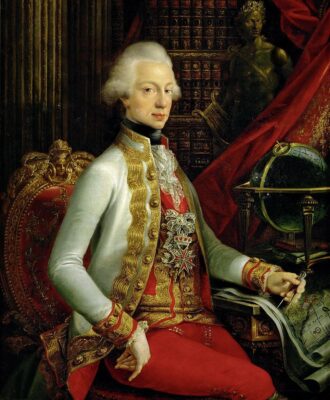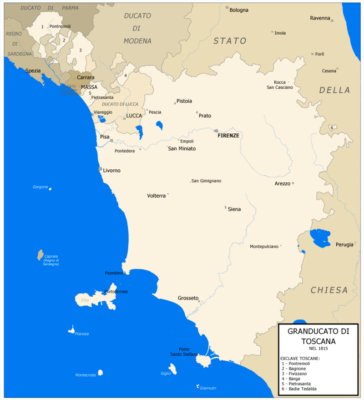Grown Up
In August 1458 the papal conclave would elect Enea Bartolomeo Piccolomini, a member of a Sienese noble but impoverished family of 18 children as Pope Pius II. He exercised his power in order for Siena to accept the return of the exiled noble families related to the Noveschi regime, banned from the city for more than 100 years. In 1460 he raised the religious status of his hometown by making it the seat of an archbishopric and anointed his nephew Francesco Piccolomini as an archbishop and cardinal.
His nephew would also become a Pope as Pius III in 1503. Finally in 1461 he canonized Saint Catherine of Siena (one of the two patron saints of Italy today), who had played an instrumental role in bringing back the Papacy to Rome from its exile in Avignon towards the end of 1380.
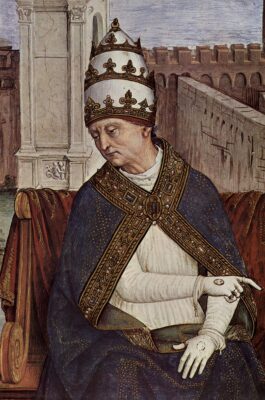
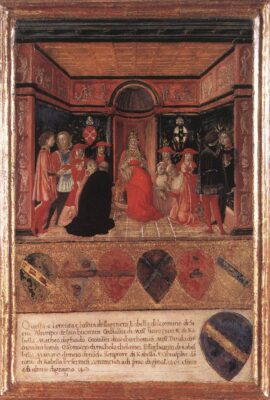
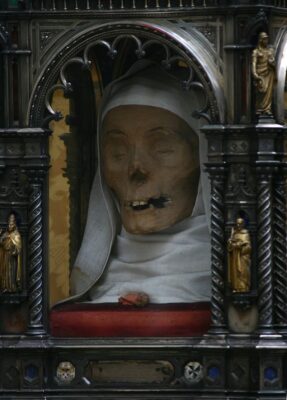

The heritage of the first Piccolomini term in the papal throne is still evident today through the two landmark buildings funded by him, the Loggia del Papa constructed in 1462 and the Palazzo Piccolomini, completed 31 years after the pope’s death in 1495.
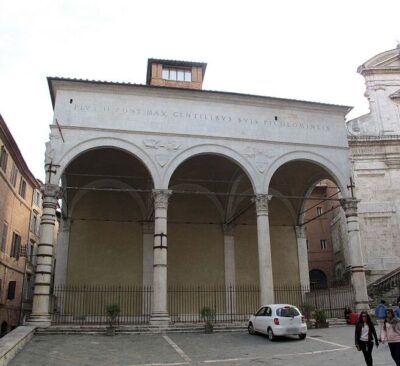
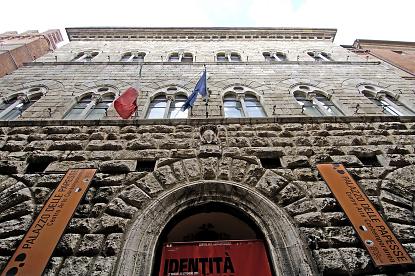

After the return of the Noveschi nobles the Sienese were mostly divided between two parties. The Monte dei Nove, the party of the Nine, that represented the interests of the wealthy bourgeois merchants and the Monte del Popolo, the party of the people that held the government from the late 14th century.
Just a few years after their return and according to the customs of the vicious infighting between different fractions of the Italian political scene at the time, the members of the party of the Nine were banished from Siena and their possessions were confiscated by the government in 1483. Among them the Petrucci brothers, Pandolfo & Giacoppo, leading figures of the party.
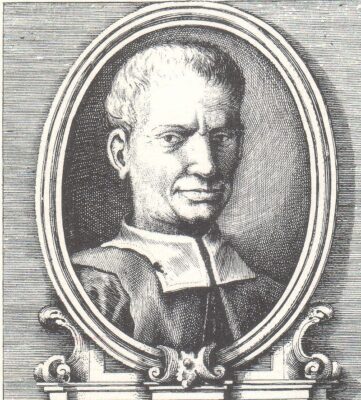
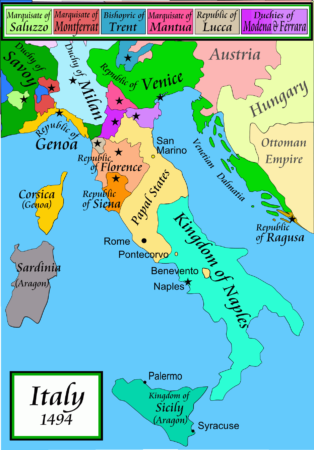
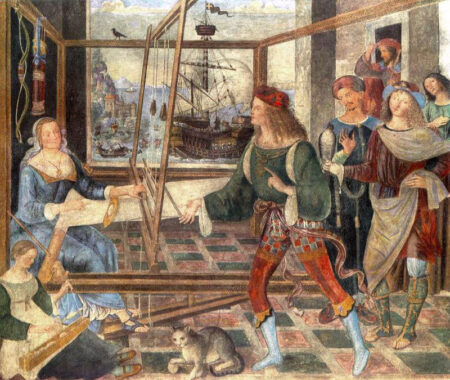
In 1487 the exiles returned to Siena and after a successful and bloody coup managed to seize the government and reverse the roles. Following a course parallel to the ascendancy of the Medici in Florence, the Borgias in the Papal States or the Sforzas in Milan, the Petruccis of Siena managed through shrewd diplomacy, effective alliances and rational pragmatism to establish themselves as the essential rulers by 1496. After the death of his brother in 1497, Pandolfo Petrucci became the sole “Defensor Libertatis” of Siena or in other words the city’s overlord.
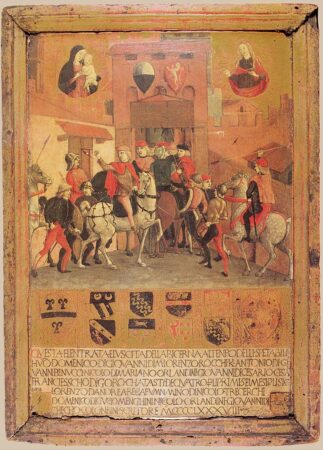
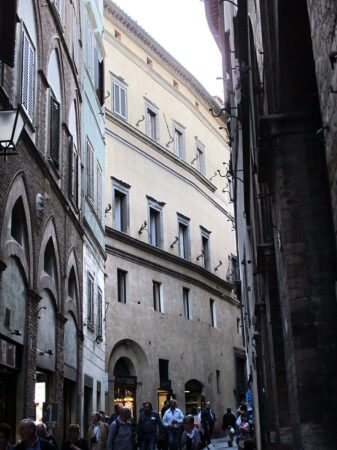

Although Petrucci ruled as an absolute tyrant his experience in the turbulent Sienese politics would help him navigate in the Italian chess-board like a master and steer his city in another short (he died in 1512) but distinctively prosperous period. The coincidence of the second Piccolomini papacy in 1503 would favor the development of the arts with artists like Michelangelo, Pinturicchio & Raphael contributing with their works in the rejuvenation of the Scuola Senese. It would also give birth to a masterpiece of Renaissance architecture, the Piccolomini Library commissioned by Pope Pius III to house the library of humanist texts assembled by his uncle.

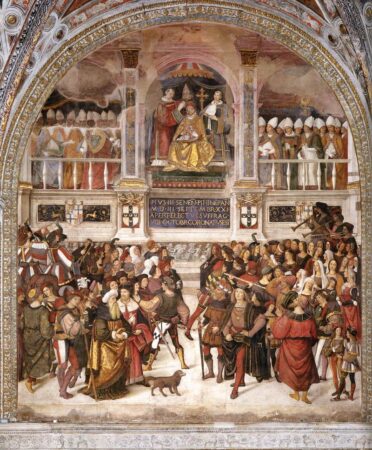
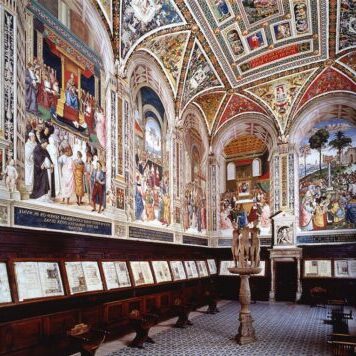
The Petruccis would hold on to the power until 1525 when the Sienese managed to overthrow Pandolfo‘s youngest son, Fabio who was exiled from the city according to the customs of the era. Their Palazzo del Magnifico would be a remainder of their rise to power in perpetuity. A new round of domestic upheaval and set of exiles once again against the Noveschi party members motivated Pope Clement VII who decided to side with the Florentines and send a joint army to Siena in the summer of 1526.
By then the city’s population had waned down to less than 15.000 people, a size considerably smaller to that of Florence. On St. Christopher’s day, July 25th , 1526, at the gates of the city known as Porta Camollia, an army of no more than 400 Sienese managed in an almost miraculous way to crush an army of 5.000 who left behind all their wagons and artillery. The collapse and panicked retreat of the attackers was perceived as something supernatural by the Sienese and as cowardly by the Florentines.
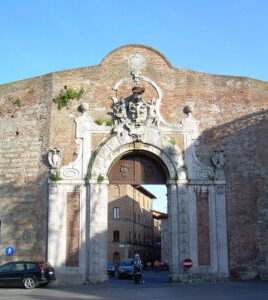
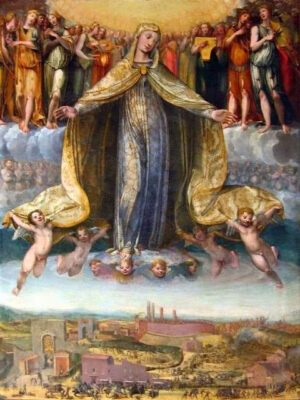
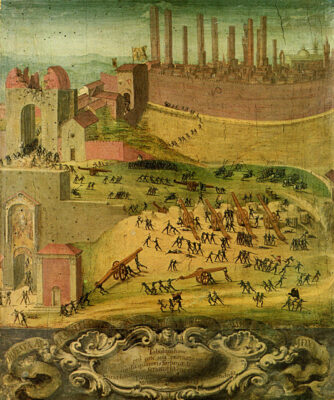
The great powers of the time, the Habsburg Empire and France were entangled in a series of wars from the late 15th century on Italian soil. When Emperor Charles V decided to impose the construction of a fortress that would house its Spanish garrison in 1550, the Sienese turned to the French King Henry II who in 1551 declared war against the Habsburg Empire. In January 1554, Siena was under siege by Gian Giacomo Medici, commander of a joint Spanish-Florentine army which by June numbered 15.000 strong.
Piero Strozzi, a Florentine exile was in charge of the French army of about the same size. In August 2, 1554, the Franco-Sienese army was crushed in the Battle of Scannagallo (also known the Battle of Marciano), annihilating any hope for relief. The battle would mark the official ending of the Republic of Siena as an independent self-governed state.
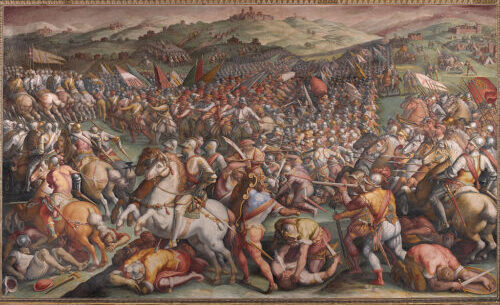
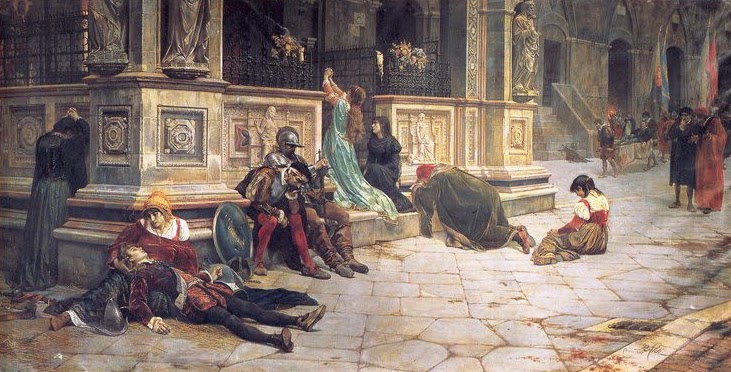
The city itself surrendered in April 1555, after 18 long months of resistance. The Black and White flag came down to give way to the Medici coat of arms. Cosimo I De’ Medici, second Duke of Florence (1537 to 1569) celebrated by ceremonially entering the city in 1557 and watching a play in the Palazzo Pubblico. The people of Florence rejoiced the decisive blow to their Tuscan nemesis with three days of festivities when in the same time about six hundred powerful Sienese families escaped to nearby Montalcino in order to keep the flame of the Republic alive. They too would surrender in 1559.

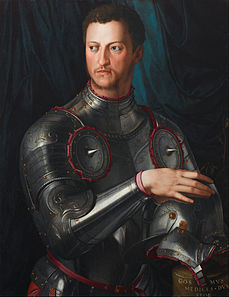

The Grand Duchy of Tuscany would be constituted by the Duchy of Florence and the autonomous Duchy of Siena (Ducato di Siena or Stato Nuovo di Siena). The two states would be separated in their political and judiciary systems but united under one ruler. Although the strictly local matters were run by the local magistrates, governors, judges and government members the fate of the state as a whole would be designated by the House of Medici in Florence for the next 200 years.
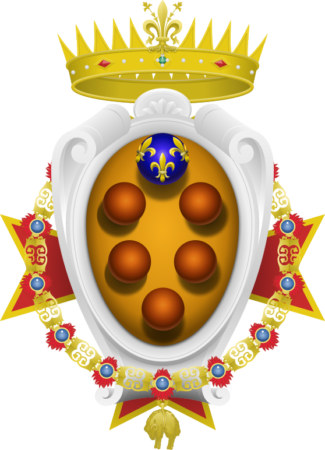
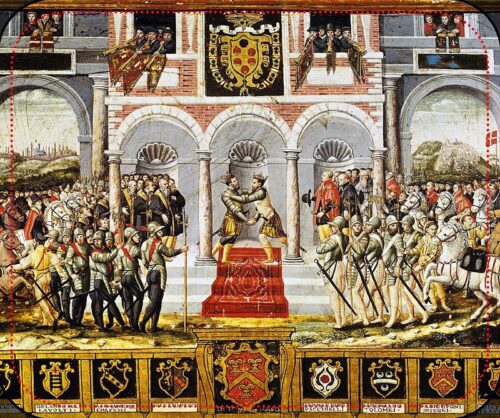
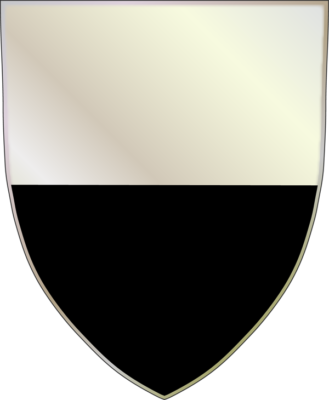
The integration of Siena in the Granducato brought little if any benefits to the city. A customs barrier between the two former states was maintained and the population of the capital city fell to its lowest point (below 10.000). The pride of the once mighty Sienese identity found refuge in religion.
The worship to the Madonna of Provenzano had taken the form of a Sienese cult that was rewarded by Pope Urban VIII with the erection of the lush Church of Santa Maria di Provenzano in 1595. In 1611 the solemn consecration of the church was linked to the old tradition of the Palio which took its famous form we know today. Two years later the baroque renovation of the Church of San Martino was completed.


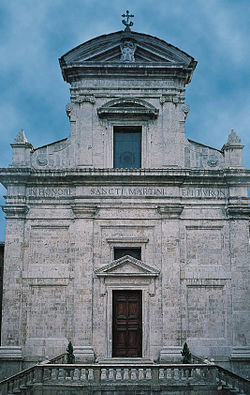
Furthermore the once strong suit of the Sienese had not vanished. A small pawnshop established by the magistrates of the Republic in 1478 called Monte Pio would expand its activities in order to serve the interests of the upper classes and in 1580 it would take the character of a public bank carrying out several tax collection services. A second branch called Monte dei Paschi specialized in agricultural credit would be established in 1624. The unification of the two known as Banca Monte dei Paschi di Siena is considered today the oldest operating bank in the world.
The extinction of the Medici dynasty, the takeover of the Granducato of Tuscany by the House of Habsburg-Lorraine and the radical reforms introduced by Leopold I would revive agriculture and trade after a long period of decline. The distinction between the two Duchies of Tuscany was eliminated and the population started rising again. Siena became part of the famous Grand Tour, the culture trip made by the aristocrats of Central and Northern Europe in the cities of the Italian peninsula and Sicily. The university of Siena (Università degli Studi di Siena) was revitalized with the establishment of the Accademia dei Fisiocritici (Academy of Sciences) and the increase of of the number of its students.
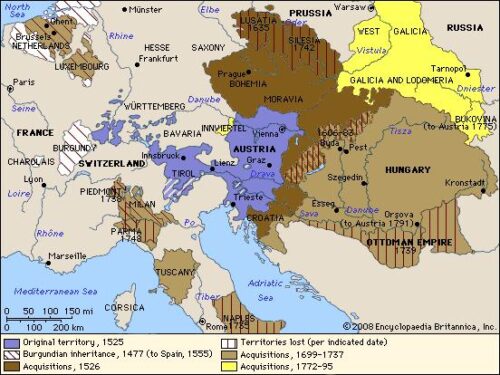
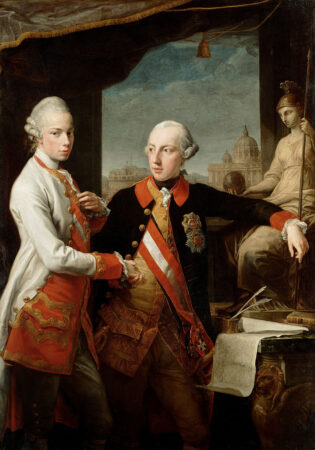
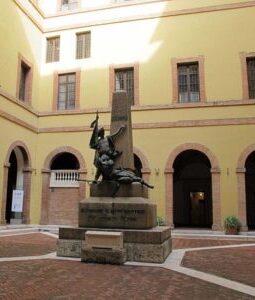
During the Napoleonic Wars the Grand Duchy of Tuscany had initially been left out by the invading French army that had started the conquest of Italy in 1796. Despite the huge amount of money payed to the French in exchange for immunity, the French invaded Tuscany in March 1799.
The neighboring to Siena city of Arezzo became the epicenter of an insurrection with the Sienese sending numerous volunteers to join the Italian army that was growing by the day. The Sienese crowd erupted burning down the tree of freedom, the symbol of the French Jacobins that was set up in Piazza del Campo. The anger against the invaders deviated in a serious incident of collateral damage when the crowd entered the ghetto of Siena abducted a number of Jews and burned them alongside the tree of freedom.
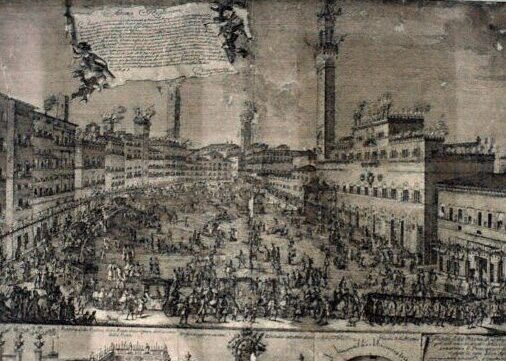
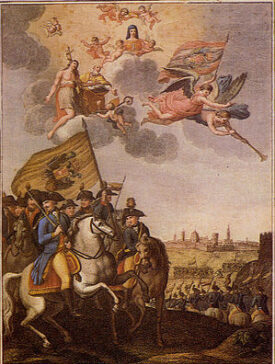
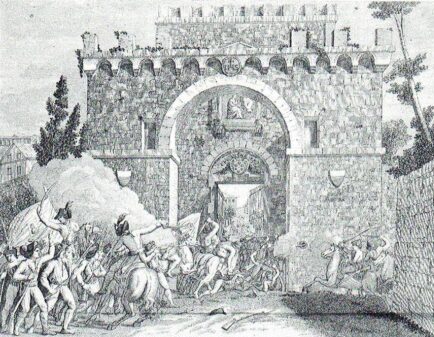
In 1801 in the context of the Treaty of Aranjuez, between Napoleonic France and Spain, the Bourbons of Parma were compensated for the loss of their territory in northern Italy with the largest part of the Grand Duchy of Tuscany which became Kingdom of Etruria and Ludovico I of Bourbon its first king.
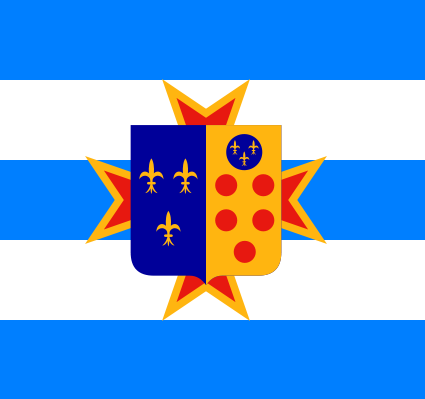
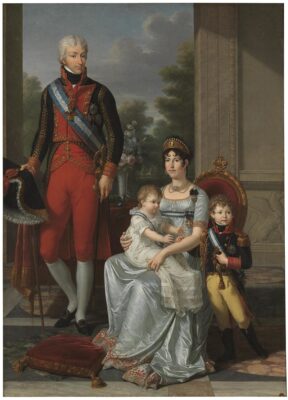
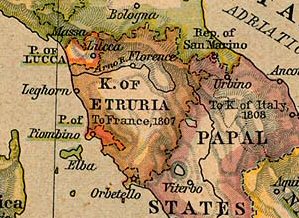
In 1807 the Kingdom of Etruria was dissolved and integrated into Imperial France, making Siena the capital of Department dell’Ombrone an area of 7,750 km², with 163,317 inhabitants. When the Napoleonic system collapsed in 1814, the Grand Duchy of Tuscany was once again restored and Ferdinand III of the Habsburg Lorraine House became its rightful ruler again (he had succeeded his father Leopold I when the latter became Emperor in 1790 until 1801 when the French took over).

